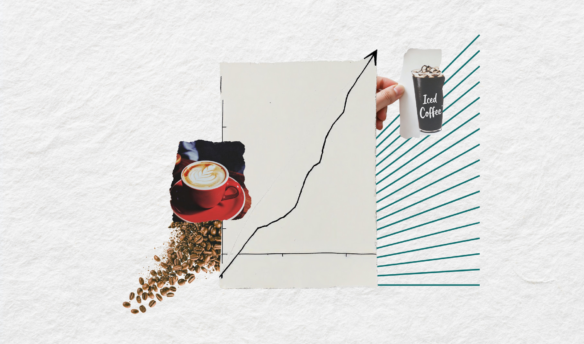Consider the humble ice cream cone. It carries a delicious treat from counter to customer, and tastes pretty good itself. Moreover, it leaves no waste behind.
Edible food packaging might sound like a contemporary trend, but the ice cream cone—invented more than a century ago—is a good reminder that the category has history, even as recent innovations are helping to make it more ubiquitous in today’s coffee shops.
Edible coffee cups and pasta straws are two common examples: While edible cups are designed to resist heat and leaks, pasta straws can replace the soggy paper straws that many people, including environmentalists, hate. Both have gained a reputation as more sustainable dishware.
The only problem? For consumers like me—I have an autoimmune condition called celiac disease—that coffee could be served with a side of gastrointestinal distress that lasts for weeks.
I’ve visited plenty of cafes with allergy-friendly protocols in place, like allergy labeling, separate food prep spaces, and designated milk steaming jugs. But as more food service businesses switch out their plastic straws and styrofoam cups for edible and biodegradable packaging as part of their sustainability goals, they can become a serious allergen blind spot.
Multiple studies have shown that plates, forks, knives, straws, and cups made from wheat bran, for example, can leach allergens up to 10 times the amount that triggers an immune reaction for celiacs. At the same time as it acknowledges the need for more sustainable packaging, the Association of European Coeliac Societies (AOECS) writes that a lack of precautionary allergen labeling for novel bio-based packaging could “risk undermining the safety of millions of consumers.”
Millions is right. An increasing number of people, including many coffee lovers, are navigating celiac disease and multiple food allergies. Around 11% of U.S. adults—approximately 27 million people—have at least one food allergy, and insurance claims for anaphylactic reactions rose 377% between 2007 and 2016. Meanwhile, studies show a 7.5% increase per year in the incidence of celiac disease, affecting 1% of the global population overall.
And yet, many people, including those with allergies, remain unaware that biodegradable packaging can contain allergens. But more and more packaging suppliers are working to communicate allergens clearly, helping food service businesses to provide both a sustainable and safe experience for all customers.
Plant-Based, But Not Always Allergy-Friendly
As food service businesses explore more sustainable dishware options, many packaging manufacturers have developed certified-biodegradable food contact materials (FCMs) like containers and cutlery. These use less energy and create less waste than conventional plastic, while maintaining comparable resistance to oil and water. When biodegradable FCMs end up in landfills or the ocean, they are often designed to break down within months or years, versus centuries, without leaving microplastics or toxic residues behind.
Another option gaining popularity is edible dishware and films. Many have promising zero-waste applications, are inherently biodegradable, and theoretically leave behind no waste after being eaten. So far, edible packaging has been used for everything from coffee and water to meat and cupcakes, often with a sustainability mission.
However, many of the materials needed to make biodegradable and edible packaging are found among the top nine allergens in the U.S. and the top 14 allergens in the United Kingdom and European Union—and there’s still not enough information on how they might leach allergens into food.
The stakes are high for coffee lovers like Allie Fox, a Tennessee-based project manager who developed adult-onset allergies to dairy and eggs. She has already stopped visiting a particular coffee chain after repeatedly receiving her almond milk latte with a syrup that contains heavy cream. “It’s happened enough that I have lost faith in [them] to serve me as an allergy-friendly place,” Fox says.
To serve food efficiently, bio-based packaging must hold its structure like plastic would. In edible packaging, this calls for a mix of proteins and carbohydrates. In biodegradable dishware, raw ingredients are sometimes processed into biopolymers like PHA and PLA that mimic conventional plastic.
Manufacturers often use substances like seaweed, milk proteins like casein and whey, and gluten-containing starches like wheat and barley because they bind together easily. (Although seaweed is not technically seafood, it may still come into contact with allergenic marine animals.) Some studies have considered how chitosan, a sugar derived from the outer skeleton of shellfish like crab and shrimp, can replace conventional plastic FCMs like containers and films.
Unlike allergens in prepared and packaged foods, businesses are not currently required to label allergens in packaging in either the U.S. or EU. But if Fox were served coffee in an edible cup that contained whey or egg powder, it could cause an immediate reaction. “Luckily, I don’t go into anaphylactic shock, but my reactions are still miserable,” she says. “If I eat something accidentally, I’ll be running to the bathroom in seconds.”
The wheat bran-based FCMs used in the leaching studies are still not widespread in the U.S. But Tricia Thompson MS, RD, the founder of Gluten Free Watchdog, LLC, which tests and reports on the gluten content of consumer packaged goods, says they’re still concerning.
“The study authors are calling on regulatory agencies to require mandatory labeling of allergens on biodegradable FCMs. [We] agree with this request,” Thompson says, adding that Gluten Free Watchdog contacted the U.S. Food and Drug Administration to raise awareness about the results.
Balancing Sustainability and Allergy Inclusivity
The good news is that FCMs can also be made from alternative plant-based materials that don’t contain any top allergens. These include FCMs made from sugarcane; gluten-free grains like sorghum and buckwheat; starches from potato, corn, and rice; and mycelium root structures from mushrooms.
Many biodegradable packaging manufacturers address allergens on their website, including Vegware (various plant-based materials), PrimeWare (molded fiber), phade® (canola oil-based PHA), StrawFish (a resin made from reclaimed seashells), and Notpla (seaweed). In addition to offering allergen-friendly packaging, these manufacturers’ bio-based materials can reduce the environmental impact of takeaway packaging. For example, Notpla’s partnership with popular delivery service Just Eat in the U.K. aims to replace plastic boxes with biodegradable seaweed-lined takeaway boxes, which they say will avoid plastic from entering waste streams and reduce carbon emissions by 70% over plastic alternatives.
Phade, which manufactures straws, is owned by the packaging manufacturer WinCup Inc. “The importance of finding new materials to replace single-use plastics became clear a few years ago, when a video of a turtle with a plastic straw stuck in its nose went viral and shocked the world,” says WinCup CEO Brad Laporte. “At that point, WinCup made a strategic decision to look for innovative alternatives to traditional materials”—in their case, canola-based PHA.
This approach resulted in a straw that is compostable and marine biodegradable, claims that WinCup has confirmed with third-party certification to ensure consumers the packaging does what it says. It’s also allergen-free. “Even if a user is sensitive to canola oil, the fermentation process to convert it into PHA makes the product allergen-free,” Laporte says. “We have sold over two billion straws and received dozens of questions about allergens, without a single report about allergic reactions caused by the straws.”
That said, people can develop allergies to literally any food, says Carla Carter, OTR/L, director of outreach and programming at the National Celiac Association. As a result, she says, “the use of sustainable non-food replacements is ideal.” Biodegradable non-food packaging can be made from bamboo and wood cellulose, for example. But when it comes to food-based packaging, avoiding the top allergens is a good starting point.
“We very much support all efforts to reduce single-use plastics in our environment and hope that it can be done in a sustainable yet safe and transparent way for consumer safety, with all ingredients of said items called out and/or labeled in some way,” Carter says.
Bring All Customers to the Table
Although they’re still an imperfect sustainability solution, biodegradable and allergen-free FCMs offer a lot of potential. Some cafes, like Crema Coffee Roasters, offer sorting bins to ensure their packaging is composted.
And in a perfect world, managing allergies or celiac shouldn’t be at odds with living more sustainably. Because customers still don’t expect allergens in their packaging, cafes can provide a safe experience by volunteering allergen information proactively. A product’s ingredients and trace allergens can often be found on the original packaging or on the manufacturer’s website, and cafes can train staff to communicate allergen risks.
“Realistically, consumers should at least be told about the presence of gluten and allergens,” says Thompson.
For now, cafes might also choose to keep plastic or paper packaging on hand for customers who bring their allergies to your attention. Most importantly, Thompson says, “If a customer orders a beverage, don’t [automatically] stick a pasta straw into the cup!”
















